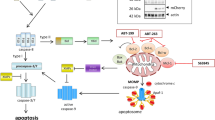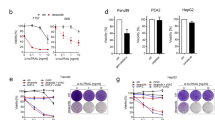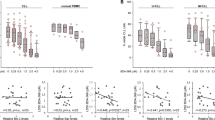Abstract
Bc1-2 protein is a potent anti-apoptotic protein that inhibits a mitochondria-operated pathway of apoptosis in many cells. DNA damaging agents and death receptor ligands can activate this mitochondrial apoptotic mechanism. Tumor necrosis factor-related apoptosis-inducing ligand (TRAIL) has been suggested to escape from the inhibitory action of Bc1-2 protein. We show that in human breast tumor MCF-7 cells, TRAIL induced a mitochondrial pathway of apoptosis that involved cytochrome c release from mitochondria and activation of caspase 9. The DNA damaging drug doxorubicin also activated this mitochondria-regulated mechanism of apoptosis, which was inhibited in Bc1-2-overexpressing cells. We also demonstrate that in MCF-7 cells Bc1-2 might confer resistance to TRAIL-induced apoptosis, depending on the expression levels of the anti-apoptotic protein. These results indicate that enhanced expression of Bc1-2 in tumor cells can render these cells less sensitive not only to chemotherapeutic drugs but also to TRAIL.
This is a preview of subscription content, access via your institution
Access options
Subscribe to this journal
Receive 50 print issues and online access
$259.00 per year
only $5.18 per issue
Buy this article
- Purchase on Springer Link
- Instant access to full article PDF
Prices may be subject to local taxes which are calculated during checkout




Similar content being viewed by others
References
Ashkenazi A, Dixit VM . 1999 Curr. Opin. Cell Biol. 11: 225–260
Ashkenazi A, Pai RC, Fong S, Leung S, Lawrence DA, Marsters SA, Blackie C, Chang L, McMurtrey AE, Hebert A, DeForge L, Koumenis IL, Lewis D, Harris L, Bussiere J, Koeppen H, Shahrokh Z, Schwall RH . 1999 J. Clin. Invest. 104: 155–162
Bodmer JL, Holler N, Reynard S, Vinciguerra P, Schneider P, Juo P, Blenis J, Tschopp J . 2000 Nat. Cell Biol. 2: 241–243
Chaudhary PM, Eby M, Jasmin A, Bookwalter A, Murray J, Hood L . 1997 Immunity 7: 821–830
Degli-Esposti MA, Dougall WC, Smolak PJ, Waugh JY, Smith CA, Goodwin RG . 1997a Immunity 7: 813–820
Degli-Esposti MA, Smolak PJ, Walczak H, Waugh J, Huang CP, DuBose RF, Goodwin RG, Smith CA . 1997b J. Exp. Med. 186: 1165–1170
Griffith TS, Wiley SR, Kubin MZ, Sedger LM, Maliszewski CF, Fanger NA . 1999 J. Exp. Med. 189: 1343–1354
Gross A, Jockel J, Wei MC, Korsmeyer SJ . 1998 EMBO J. 17: 3878–3885
Hinz S, Trauzold A, Boenicke L, Sandberg C, Beckmann S, Bayer E, Walczak H, Kalthoff H, Ungefroren H . 2000 Oncogene 19: 5477–5486
Kayagaki N, Yamaguchi N, Nakayama M, Kawasaki A, Akiba H, Okumura K, Yagita H . 1999 J. Immunol. 162: 2639–2647
Keogh SA, Walczak H, Bouchier-Hayes L, Martin SJ . 2000 FEBS Lett. 471: 93–98
Kischkel FC, Lawrence DA, Chuntharapai A, Schow P, Kim KJ, Ashkenazi A . 2000 Immunity 12: 611–620
Kluck RM, Bossy-Wetzel E, Green DR, Newmeyer DD . 1997 Science 275: 1132–1136
Kroemer G, Zamzami N, Susin SA . 1997 Immunol. Today 18: 44–51
Li P, Nijhawan D, Budihardjo I, Srinivasula SM, Ahmad M, Alnemri ES, Wang X . 1997 Cell 91: 479–489
Liu X, Kim CN, Yang J, Jemmerson R, Wang X . 1996 Cell 86: 147–157
MacFarlane M, Merrison W, Dinsdale D, Cohen GM . 2000 J. Cell. Biol. 148: 1239–1254
Mariani SM, Matiba B, Armandola EA, Krammer PH . 1997 J. Cell. Biol. 137: 221–229
Marsters SA, Sheridan JP, Pitti RM, Huang A, Skubatch M, Baldwin D, Yuan J, Gurney A, Goddard AD, Godowski P, Ashkenazi A . 1997 Curr. Biol. 7: 1003–1006
Martinez-Lorenzo MJ, Alava MA, Gamen S, Kim KJ, Chuntharapai A, Pineiro A, Naval J, Anel A . 1998 Eur. J. Immunol. 28: 2714–2725
Mongkolsapaya J, Grimes JM, Chen N, Xu XN, Stuart DI, Jones EY, Screaton GR . 1999 Nat. Struct. Biol. 6: 1048–1053
Murphy KM, Ranganathan V, Farnsworth ML, Kavallaris M, Lock RB . 2000 Cell Death Differ. 7: 102–111
Murphy KM, Streips UN, Lock RB . 1999 Oncogene 18: 5991–5999
Pan G, Ni J, Wei YF, Yu G, Gentz R, Dixit VM . 1997a Science 277: 815–818
Pan G, O'Rourke K, Chinnaiyan AM, Gentz R, Ebner R, Ni J, Dixit VM . 1997b Science 276: 111–113
Phillips TA, Ni J, Pan G, Ruben SM, Wei YF, Pace JL, Hunt JS . 1999 J. Immunol. 162: 6053–6059
Pitti RM, Marsters SA, Ruppert S, Donahue CJ, Moore A, Ashkenazi A . 1996 J. Biol. Chem. 271: 12687–12690
Rochaix P, Krajewski S, Reed JC, Bonnet F, Voigt JJ, Brousset P . 1999 J. Pathol. 187: 410–415
Ruiz-Ruiz C, Muñoz-Pinedo C, Lopez-Rivas A . 2000 Cancer Res. 60: 5673–5680
Scaffidi C, Fulda S, Srinivasan A, Friesen C, Li F, Tomaselli KJ, Debatin KM, Krammer PH, Peter ME . 1998 EMBO J. 17: 1675–1687
Schneider P, Bodmer JL, Thome M, Hofmann K, Holler N, Tschopp J . 1997 FEBS Lett. 416: 329–334
Sheridan JP, Marsters SA, Pitti RM, Gurney A, Skubatch M, Baldwin D, Ramakrishnan L, Gray CL, Baker K, Wood WI, Goddard AD, Godowski P, Ashkenazi A . 1997 Science 277: 818–821
Shi-Yong S, Ping Y, Jun-Ying Z, Yinghong W, Hyeong-Reh CK, Reuben L, GenSheng W . 2001 Biochem. Biophys. Res. Commun. 280: 788–797
Sprick MR, Weigand MA, Rieser E, Rauch CT, Juo P, Blenis J, Krammer PH, Walczak H . 2000 Immunity 12: 599–609
Srinivasula SM, Ahmad M, Fernandes-Alnemri T, Alnemri ES . 1998 Mol. Cell 1: 949–957
Srinivasula SM, Datta P, Fan XJ, Fernandes-Alnemri T, Huang Z, Alnemri ES . 2000 J. Biol. Chem. 275: 36152–36157
Walczak H, Bouchon A, Stahl H, Krammer PH . 2000 Cancer Res. 60: 3051–3057
Walczak H, Degli-Esposti MA, Johnson RS, Smolak PJ, Waugh JY, Boiani N, Timour MS, Gerhart MJ, Schooley KA, Smith CA, Goodwin RG, Rauch CT . 1997 EMBO J. 16: 5386–5397
Wang, J, Zheng L, Lobito A, Chan FK, Dale J, Sneller M, Yao X, Puch JM, Straus SE, Lenardo MJ . 1999 Cell 98: 47–58
Wiley SR, Schooley K, Smolak PJ, Din WS, Huang CP, Nicholl JK, Sutherland GR, Smith TD, Rauch C, Smith CA . 1995 Immunity 3: 673–682
Yang J, Liu X, Bhalla K, Kim CN, Ibrado AM, Cai J, Peng TI, Jones DP, Wang X . 1997 Science 275: 1129–1132
Yang QF, Sakurai T, Yoshimura G, Shan L, Suzuma T, Tamaki T, Umemura T, Kokawa Y, Nakamura Y, Nakamura M, Tang W, Utsunomiya H, Mori I, Kakudo K . 2000 Breast Cancer Res. Treat. 61: 211–216
Yeh WC, Pompa JL, McCurrach ME, Shu HB, Elia AJ, Shahinian A, Ng M, Wakeham A, Khoo W, Mitchell K, El-Deiry WS, Lowe SW, Goeddel DV, Mak TW . 1998 Science 279: 1954–1958
Zou H, Henzel WJ, Liu X, Lutschg A, Wang X . 1997 Cell 90: 405–413
Acknowledgements
pcDNA3-bc1-2 plasmid was kindly provided by Dr Jacint Boix (University of Lleida, Lleida, Spain). This work was supported by grants from the Comisión Interministerial de Ciencia y Tecnología (1FD97-0514-C02-01 and SAF2000-0118-C03-01) to A López-Rivas. C Ruiz de Almodóvar and C Muñoz-Pinedo were recipients of fellowships from Fondo de Investigación Sanitaria (FIS, Exp. 00/9319) and Formación de Personal Investigador (FPI), respectively.
Author information
Authors and Affiliations
Corresponding author
Rights and permissions
About this article
Cite this article
de Almodóvar, C., Ruiz-Ruiz, C., Muñoz-Pinedo, C. et al. The differential sensitivity of Bc1-2-overexpressing human breast tumor cells to TRAIL or doxorubicin-induced apoptosis is dependent on Bc1-2 protein levels. Oncogene 20, 7128–7133 (2001). https://doi.org/10.1038/sj.onc.1204887
Received:
Revised:
Accepted:
Published:
Issue Date:
DOI: https://doi.org/10.1038/sj.onc.1204887
Keywords
This article is cited by
-
Glucocorticoid receptor antagonist sensitizes TRAIL-induced apoptosis in renal carcinoma cells through up-regulation of DR5 and down-regulation of c-FLIP(L) and Bcl-2
Journal of Molecular Medicine (2012)
-
ER stress sensitizes cells to TRAIL through down-regulation of FLIP and Mcl-1 and PERK-dependent up-regulation of TRAIL-R2
Apoptosis (2012)
-
A proteomic investigation into adriamycin chemo-resistance of human leukemia K562 cells
Molecular and Cellular Biochemistry (2011)
-
Roscovitine sensitizes breast cancer cells to TRAIL-induced apoptosis through a pleiotropic mechanism
Cell Research (2008)
-
BP1 transcriptionally activates bcl-2and inhibits TNFα-induced cell death in MCF7 breast cancer cells
Breast Cancer Research (2007)



